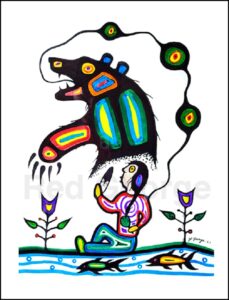Lambton Heritage Museum announces new name for local bear

By Colin Graf
LAMBTON SHORES — Having barely arrived in this area a few months earlier, the first visitor of the species in decades has been given an Anishinaabemowin name by the winner of the local “Name the Bear” contest. The animal, which has been spotted in an area ranging along the southern Lake Huron shore since last May, attracted more than 350 contest entries, many in the ancestral language, according to Nnigiiwemin/We Are Going Home exhibition co-curator Summer Bressette, of Chippewas of Kettle & Stony Point First Nation (KSP).
The bear’s name, Benjamin Mawinzo, submitted by local resident Chris Harrington, was declared the winner because he “demonstrated a lot of research and thoughtfulness,” says Bressette. The surname, Mawinzo, roughly translates as “she/he picks berries”, although the exact translation may be different from region to region, according to Bressette and co-curator Monica Virtue. The winner will receive the original painting “Sacred Bear” from KSP artist Jeffrey “Red” George, as well as an exclusive tour of the upcoming exhibition Nnigiiwemin/We Are Going Home at the nearby Lambton Heritage Museum and a free museum pass.
“[He] had done a lot of research that was really genuine, we took note of that; there was an entire write-up to accompany his entry,” Bressette explains.
The visitor will bear two names inspired by a favourite food source of its kind; berries. The name Benjamin comes from a local settler from the 1870s who was active with the fruit growers association and was a voice for environmental preservation, the release says.
The curators were surprised by the number of entries and by the extensive use of Anishinaabemowin (which awarded the contestants with extra points) in the contest, notes Bressette. A further surprise was that most entries came from settlers rather than Kettle & Stony Point members, as many of the bear sightings have been on or near the woodland on the Stony Point land. Bressette recognizes that inviting non-Indigenous people to use Anishinaabemowin was risking cultural appropriation. She was very impressed by the care with which people crafted their entries, and “showed real interest in self-educating,” adding that many used the University of Minnesota Ojibway People’s Dictionary.
The idea for the naming contest came from Red George, according to Virtue, a designer, researcher, and filmmaker who is in the process of completing a documentary on the Ipperwash Crisis, conducted treaty research for First Nations, and held treaty workshops for school boards.
The artist warned her to watch out for the bear when she was gathering natural materials for the museum exhibit and playfully suggested the bear really should have a name.
That was “the light-bulb moment” that led her to suggest the contest. The artist “very generously” donated the painting for the winner. She was “blown away” when George offered a new painting, professionally framed.
The museum exhibit, Nnigiiwemin/We Are Going Home, examines the relationship between colonialism and the loss of land by KSP. A response to the 25th anniversary of the “Ipperwash Crisis” of 1995, the exhibit introduces the concept of Chi‐Naaknigewin, or Natural Law, as a driving force for land and water protection. Using interviews, maps, moving images, soundscapes, and wampum, it illustrates the relationship between people, land, and Anishinaabeg Nationhood. The exhibit also features illustrations by KSP author and illustrator Bridget George. It runs at the Lambton Heritage Museum on Highway 21 from Aug. 4 – Sept. 26.
The arrival of the bear has caused some excitement in her community and concern for the creature’s well-being, Bressette says. Kettle and Stony Point people aren’t afraid of the bear, although cottagers in the area have shown more worry, she says.
“[That] speaks to different cultural worldviews,” she says. “We know to let the bear be.”
KSP Chief Jason Henry took note of the bear in a Facebook post this spring.
“Some of you may have seen the recent video of the black bear at Stony Point. Please don’t disturb them, they too just want to return home to Aazhoodena to live in peace on their territory. Please don’t shoot them, don’t scare them, they have been in Stony since last spring and have not harmed anyone. Boozhoo Makwa’s and welcome home to Aazhoodena,” he wrote.
Selecting the top entries in the naming contest was a long job but a rewarding one for Bressette and Virtue.
“We ended up with this large, multi-page spreadsheet,” Virtue says, trying to sort through entries, with lots of funny responses, many meaningful ones. “[And] a few that were really cute.”
In that last category was one favourite, “Blueberry”, submitted by a parent on behalf of a young child.
Several other contest entries were named runners-up and given a free pass to the Museum, including Niibin Nagweyaab (Summer Rainbow), Niikon (brother), Bami the Mukwa (meaning to take care of), Clarence, Giiwe (to go home), Mashikiki Mukwa (medicine bear), and Aakodewewin (bravery).
Bressette notes that participation hesitancy amongst community members is attributed to the museum itself.
“These are institutions we have traditionally not been involved with, only as subjects,” she explains, having worked at a local museum and curating Indigenous programming for the London Arts Council. “It can be really hard for Anishinabe folk to walk through the doors. Oftentimes, we are still perceived as cultures under glass.”
Through her work with the Lambton Heritage Museum, she has been impressed with the staff that she has worked with. She says that they have read the calls-to-action from the Truth and Reconciliation Commission dealing with their field and are working to include Indigenous voices and to be inviting to First Nations visitors.

